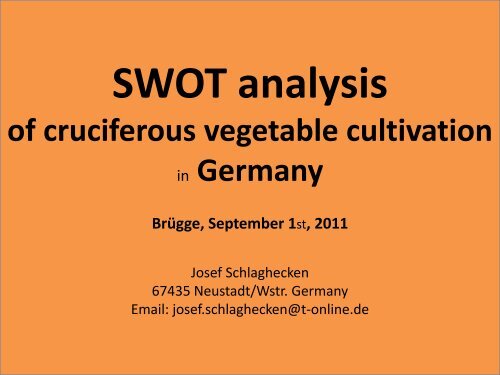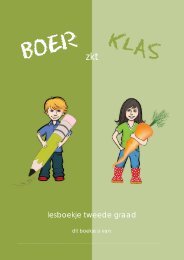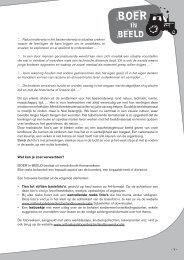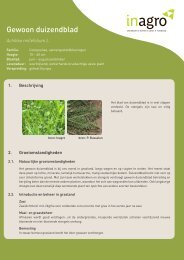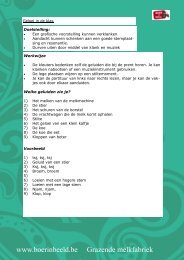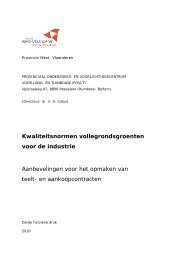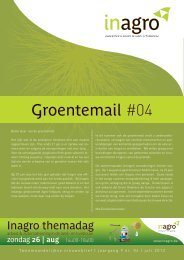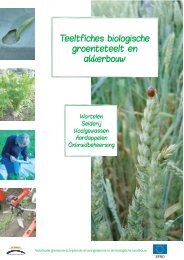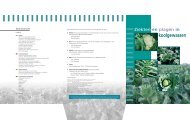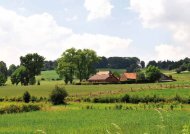You also want an ePaper? Increase the reach of your titles
YUMPU automatically turns print PDFs into web optimized ePapers that Google loves.
SWOT analysisof cruciferous vegetable cultivation<strong>in</strong> <strong>Germany</strong>Brügge, September 1st, 2011Josef Schlaghecken67435 Neustadt/Wstr. <strong>Germany</strong>Email: josef.schlaghecken@t-onl<strong>in</strong>e.de
Vegetable crops area (ha) <strong>in</strong> <strong>Germany</strong>!84,526 ha99,937 ha107,771 ha112,328 haVegetable vegetable crops:In 15 years + 33%Cruciferous crops<strong>in</strong> 15 yearsa decrease of 6%Crucifereous crops25,669 ha 25,631 ha 24,800 ha 24,191 haProportion of cruciferous crops of the German vegetable area (%)30% 26% 23% 22%1995 2000 2005 2010
CropCruciferous crops <strong>in</strong> <strong>Germany</strong>Area1995 haArea2010 ha+ / -2010 to 1995Open air vegetable 84,526 ha 112,328 ha 33 %Cruciferae family 25,669 ha 24,191 -6%Red cabbage 3,155 ha 2,213 ha -30 %Savoy cabbage 1,483 ha 1,065 ha -28 %Cauliflower 5,959 ha 4,491 ha -25 %Radish large 991 ha 765 ha -23 %White cabbage 7,626 ha 6,130 ha -20 %Ch<strong>in</strong>ese Cabbage 1,062 ha 1,046 ha -2 %Kohlrabi 2,267 ha 2,329 ha 3 %Brussels Sprouts 575 ha 721 ha 25 %Broccoli 1,173 ha 2,057 ha 75 %Radish small 1,378 ha 3,374 ha 145 %Cruciferae % of thevegetable area <strong>in</strong> <strong>Germany</strong>30% 22%
SWOT analysisBrussels sprouts<strong>in</strong> <strong>Germany</strong>
Brussels sprouts <strong>in</strong> <strong>Germany</strong>(Brassica oleracea var. gemmifera)CountryStateArea2010 (ha) (+/-2005)Area2005 ha<strong>Germany</strong>(2010 = 100 %)721 ha (-10%) 807 haNorth Rh<strong>in</strong>e-Westphalia(2010 = 33 %)239 ha (- 6%) 255 ha
Important Brussels sprout area <strong>in</strong> <strong>Germany</strong>!<strong>Germany</strong> 2010: 721 ha239 haNorth Rh<strong>in</strong>e-WestphaliaBrussels sprouts <strong>in</strong> Palat<strong>in</strong>ate
Brussels sprout <strong>in</strong> <strong>Germany</strong>Mechanisation <strong>in</strong> <strong>Germany</strong>In northern <strong>Germany</strong>Photo: J. Kreiselmaier3 Photos: Semmler Lootz
SWOT analysisCh<strong>in</strong>ese cabbage<strong>in</strong> <strong>Germany</strong>
Ch<strong>in</strong>ese cabbage <strong>in</strong> <strong>Germany</strong>Brassica rapa ssp. pek<strong>in</strong>ensisCountryStateArea2010 (ha) (+/-2005)Area2005 ha<strong>Germany</strong>(2010 = 100 %)Bavaria(2010 = 23 %)Rh<strong>in</strong>eland palat<strong>in</strong>ate(2010 = 21 %)Lower Saxony(2010 = 20 %)1,046 ha (+ 6%) 991 ha244 ha (+ 42 %) 141 ha224 ha ( -1 %) 227 ha209 ha ( +1 %) 208 ha
Important Ch<strong>in</strong>ese cabbage areas <strong>in</strong> <strong>Germany</strong>!<strong>Germany</strong> 2010: 1.046 ha209 haLower SaxonyRh<strong>in</strong>eland-Palat<strong>in</strong>ateCh<strong>in</strong>ese cabbage <strong>in</strong> Palat<strong>in</strong>ate224 haBavaria244 ha
Ch<strong>in</strong>ese cabbage: Fertilization <strong>in</strong> Palat<strong>in</strong>ate1.1 Compliance with the legislation: company level and plot level1.2 Fertilization standards per haCrop period:Summer + AutumnPlant yield N P 2 O 5 K 2 O MgOUnits t/ha kg/ha kg/ha kg/ha kg/haTotal plant yield 150 240 120 480 25Removed harvestedportion of the crop1.00 150 90 300 15Fresh crop residuesthat stays <strong>in</strong> the field50 90 30 180 10FertilizationAmount (rate)Nm<strong>in</strong> target 240 kg + 40 kg = 280 kg- Nm<strong>in</strong> soil analysis: e.g. = 80 kg- N m<strong>in</strong>eralization: e.g. = 40 kgNm<strong>in</strong> to give = 160 kg0-90-170 0-300-420 0-35-801.3 Is the comb<strong>in</strong>ation of animal manure with artificial fertilizer the standard? No1.4 Is there a limit on the adm<strong>in</strong>istration period?YES, no fertilization <strong>in</strong> w<strong>in</strong>ter1.5 How are the checks conducted?European union: Adm<strong>in</strong>istrative check<strong>in</strong>g company and sometimes plot level
Ch<strong>in</strong>ese cabbage: Diseases and pests <strong>in</strong> <strong>Germany</strong>Threaten<strong>in</strong>g diseases or pests:- Alternaria brassicae and brassicocola- Verticillium dahliae and longisporum- Plasmodiophora brassicae (Kohlhernie)- Verticillium dahlie and longisporum (specily <strong>in</strong> the warmer areas)New diseases or pests:Aleyrodes proletella, Whitefly (Kohlmottenschildlaus, Weiße Fliege)(max. 3 x Plenum 50 WG = Pymetroz<strong>in</strong>e / max. 1 x Karate Zeon = Lambda-Cyhalothr<strong>in</strong>/(max 2 x Fastac SC Super Contact = alpha Cymetr<strong>in</strong>)Approach:Via resistance:- Plasmosiophora brassicae: > 50% of the varities are resistant, if nessesary helpfullVia IPM:- 100 % of the area- every week fax/email serviceVia seed coat<strong>in</strong>g/phyto-drip:- unusual
Future: Ch<strong>in</strong>ese cabbage <strong>in</strong> <strong>Germany</strong>Consumer behaviourimportance of freshness1 2 3 4 5 6 7importance of food safety1 2 3 4 5 6 7importance of convenience1 2 3 4 5 6 7New trendsReady for a salad
SWOT analysisKale<strong>in</strong> <strong>Germany</strong>
Kale <strong>in</strong> <strong>Germany</strong>(Brassica oleracea convar. sabellica)CountryStateArea2010 (ha) (+/-2005)Area2005 ha<strong>Germany</strong>(2010 = 100 %)North Rh<strong>in</strong>e-Westphalia(2010 = 47 %)Lower Saxony(2010 = 43 %)940 ha (+2%) 924 ha438 ha (-11 %) 490 ha407 ha (+48 %) 275 haSpecial crop <strong>in</strong> western and northern <strong>Germany</strong>!
Important Kale areas <strong>in</strong> <strong>Germany</strong>!<strong>Germany</strong> 2010: 940 ha407 haLower Saxony438 haNorth Rh<strong>in</strong>e-Westphalia
Future: Kale <strong>in</strong> <strong>Germany</strong>Consumer behaviourimportance of freshness1 2 3 4 5 6 7importance of food safety1 2 3 4 5 6 7importance of convenience1 2 3 4 5 6 7New trendsIn plastic bags ready for cook<strong>in</strong>g
SWOT analysisKohlrabi<strong>in</strong> <strong>Germany</strong>
Kohlrabi <strong>in</strong> <strong>Germany</strong>(Brassica oleracea var. gongylodes)CountryState<strong>Germany</strong>(2010 = 100%)Area2010 (ha) (+/-2005)2,329ha (+5 %)Area2005 ha2,210 haNorth Rh<strong>in</strong>e-Westphalia(2010 = 38%)Lower Saxony(2010 = 21%)879 ha (+16%) 753 ha486 ha (- 5%) 512 ha
Important Kohlrabi areas <strong>in</strong> <strong>Germany</strong>!<strong>Germany</strong> 2010: 2.329 ha486 haLower Saxony879 haNorth Rh<strong>in</strong>e-WestphaliaKohlrabi <strong>in</strong> Palat<strong>in</strong>ate
KohlrabiMechanisation <strong>in</strong> <strong>Germany</strong>, small farmPhotos: Semmler LootzPhoto: J. KreiselmaierPhoto: J. Kreiselmaier
KohlrabiMechanisation <strong>in</strong> <strong>Germany</strong>, large farm
Future: Kohlrabi <strong>in</strong> <strong>Germany</strong>Consumer behaviourimportance of freshness1 2 3 4 5 6 7importance of food safety1 2 3 4 5 6 7importance of convenience1 2 3 4 5 6 7New trendsDifferent k<strong>in</strong>d of packag<strong>in</strong>g
SWOT analysisHead cabbage<strong>in</strong> <strong>Germany</strong>———————————White cabbageSavoye cabbageRed cabbage
Head cabbageHead cabbage <strong>in</strong> <strong>Germany</strong>(Brassica oleracea var. capitata)CountryStateCropArea2010 (ha) (+/-2005)Area2005 ha<strong>Germany</strong> Head cabbage 9,408 ha (-1%) 9,516 ha<strong>Germany</strong> White Cabbage 6,130 ha (+0%) 6,108 ha<strong>Germany</strong> Red cabbage 2,213 ha (-1%) 2,186 ha<strong>Germany</strong> Savoy cabbage 1,065 ha (+3%) 1,200 haSchleswig-Holste<strong>in</strong>(2010 = 34% from <strong>Germany</strong>)3,172 ha (+5%) 3,018 haNorth Rh<strong>in</strong>e-Westphalia (2010= 21% from <strong>Germany</strong>) 1,971 ha (-6%) 2,088 haBavaria (2010 = 17 % from <strong>Germany</strong>) 1,607 ha (+15%) 1,397 haBaden-Württemberg (2010 = 8 % from <strong>Germany</strong>) 795 ha (-2%) 815 ha
Important Head cabbage area <strong>in</strong> <strong>Germany</strong>!<strong>Germany</strong> 2010: 9,408 ha3,172 haSchleswig-Holste<strong>in</strong>1,971 haNorth Rh<strong>in</strong>e-WestphaliaBaden-Württemberg795 ha1,607 haBavaria
White cabbage: Fertilization <strong>in</strong> Palat<strong>in</strong>ate1.1 Compliance with the legislation: company level and plot level1.2 Fertilization standards per haCrop period:Summer + AutumnPlant yield N P 2 O 5 K 2 O MgOUnits t/ha kg/ha kg/ha kg/ha kg/haTotal plant yield 150 350 110 465 40Removed harvestedportion of the crop100 200 70 315 25Fresh crop residuesthat stays <strong>in</strong> the field500 150 40 150 15FertilizationAmount (rate)Nm<strong>in</strong> target 350 kg + 40 kg = 390 kg- Nm<strong>in</strong> soil analysis: e.g. = 90 kg- N m<strong>in</strong>eralization: e.g. = 80 kgNm<strong>in</strong> to give = 220 kg0-70-150 0-315-430 0-45-851.3 Is the comb<strong>in</strong>ation of animal manure with artificial fertilizer the standard? No1.4 Is there a limit on the adm<strong>in</strong>istration period?YES, no fertilization <strong>in</strong> w<strong>in</strong>ter1.5 How are the checks conducted?European union: Adm<strong>in</strong>istrative check<strong>in</strong>g company and sometimes plot level
Head cabbage: Diseases and pests <strong>in</strong> <strong>Germany</strong>Xanthomonas campestrisXCCPlasmodiophora brassicaeClubrootPlutella xylostella, KohlmotteDiamondback mothDelia brassicaeCabbage flyBrevicoryne brassicaeCabbage aphidVogelfraßBird damage
Head cabbage: Diseases and pests <strong>in</strong> <strong>Germany</strong>New diseases or pests:Aleyrodes proletella Whitefly (Kohlmottenschildlaus, Weiße Fliege)> Plenum 50 WG (Pymetroz<strong>in</strong>e), max. 3 x> Karate Zeon (Lambda-Cyhalothr<strong>in</strong>) max. 1 x> Fastac SC Super Contact (alpha Cymetr<strong>in</strong>), max 2 xIn norther <strong>Germany</strong> less problemsApproach:– Via resistance: < 5 % of the area– Via IPM: 100 % of the area– Via seed coat<strong>in</strong>g < 10 % of the area, germ<strong>in</strong>ation could be a problem– Via phyto-drip < 5% of the area
White cabbage: SauerkrautMechanisation <strong>in</strong> <strong>Germany</strong>
White cabbage: Frish market, for cook<strong>in</strong>gMechanisation <strong>in</strong> <strong>Germany</strong>Photo: J. Kreiselmaier
White cabbage: frish market, for saladTrends <strong>in</strong> <strong>Germany</strong>Special varietiessweetsmall headsyear roundSmall heads 500-800gM<strong>in</strong>i cabbageWrapped <strong>in</strong> plastic
Future: Cabbage <strong>in</strong> <strong>Germany</strong>Consumer behaviourimportance of freshness1 2 3 4 5 6 7importance of food safety1 2 3 4 5 6 7importance of convenience1 2 3 4 5 6 7New trendsFresh cool for salad: sweet and tenderFresh cool for cook<strong>in</strong>g : good taste, m<strong>in</strong>imize strong cook<strong>in</strong>g odorSauerkraut: diversification, ready for cook<strong>in</strong>g, ready-to-eat
SWOT analysisBroccoli<strong>in</strong> <strong>Germany</strong>
Broccoli <strong>in</strong> <strong>Germany</strong>(Brassica oleracea convar. botrytis)CountryStateArea2010 (ha) (+/-2005)Area2005 ha<strong>Germany</strong>(2010 = 100%)Lower Saxony(2010 = 36%)Mecklenburg-Vorpommern(2010 = 20 %)North Rh<strong>in</strong>e-Westphalia(2010 = 13 %)Rh<strong>in</strong>eland Palat<strong>in</strong>ate(2010 = 13 %)2,057 ha ( - 3%) 2,118 ha729 ha ( - 2%) 747 ha401 ha ( -5%) 422 ha273 ha (-0%) 274 ha272 ha (-27%) 373 ha
Important Broccoli areas <strong>in</strong> <strong>Germany</strong>!Mecklenburg-Vorpommern<strong>Germany</strong> 2010: 2,057 ha401 ha727 haLowerSaxony273 haNorth Rh<strong>in</strong>e-WestphaliaBroccoli <strong>in</strong> Palat<strong>in</strong>ate272 haRh<strong>in</strong>eland-Palat<strong>in</strong>ate
Broccoli: Fertilization <strong>in</strong> Palat<strong>in</strong>ate1.1 Compliance with the legislation: company level and plot level1.2 Fertilization standards per haCrop period:Summer + AutumnPlant yield N P 2 O 5 K 2 O MgOUnits t/ha kg/ha kg/ha kg/ha kg/haTotal plant yield 90 300 95 420 40Removed harvestedportion of the crop25 105 40 115 10Fresh crop residuesthat stays <strong>in</strong> the field65 195 55 305 30FertilizationAmount (rate)Nm<strong>in</strong> target 300 kg + 40 kg = 340 kg- Nm<strong>in</strong> soil analysis: e.g. = 110 kg- N m<strong>in</strong>eralization: e.g. = 40 kgNm<strong>in</strong> to give = 190 kg0-40-120 0-115-235 0-30-701.3 Is the comb<strong>in</strong>ation of animal manure with artificial fertilizer the standard? No1.4 Is there a limit on the adm<strong>in</strong>istration period?YES, no fertilization <strong>in</strong> w<strong>in</strong>ter1.5 How are the checks conducted?European union: Adm<strong>in</strong>istrative check<strong>in</strong>g company and sometimes plot level
Broccoli: Diseases and pests <strong>in</strong> <strong>Germany</strong>Contar<strong>in</strong>ia nasturtiiSwede Midge, KohldrehherzmückeHitzeproblemeProblem of heatGenetische HerzlosigkeitGenetically bl<strong>in</strong>dnessDelia brassicaeCabbage flyBrevicoryne brassicaeCabbage aphidPlutella xylostella, KohlmotteDiamondback moth
Broccoli: Diseases and pests <strong>in</strong> <strong>Germany</strong>New diseases or pests:Aleyrodes proletella, Whitefly (Kohlmottenschildlaus, Weiße Fliege)> Plenum 50 WG (Pymetroz<strong>in</strong>e), max. 3 x> Karate Zeon (Lambda-Cyhalothr<strong>in</strong>) max. 1 x> Fastac SC Super Contact (alpha Cymetr<strong>in</strong>), max 2 xBrassicogethes aeneus, Rape Pollen Beetle (Rapsglanzkäfer), <strong>in</strong> northern <strong>Germany</strong>Approach:Via resistance: 0 % of the areaVia IPM: 100 % of the area- every week fax/email service- Contar<strong>in</strong>ia nasturtii:. Pheromone trap, for optimiz<strong>in</strong>g the <strong>in</strong>secticide application. “Break-Thru” for example is helpful
Broccoli: Level of mechanisation <strong>in</strong> <strong>Germany</strong>Middle sized farms
Broccoli: Level of mechanisation <strong>in</strong> <strong>Germany</strong>On a big farmIce is no longer the favorite
Broccoli: Harvester?Practicable <strong>in</strong> 5 years?Photo: Groenten en Fruit
Future: Broccoli <strong>in</strong> <strong>Germany</strong>Consumer behaviourimportance of freshness1 2 3 4 5 6 7importance of food safety1 2 3 4 5 6 7importance of convenience1 2 3 4 5 6 7New trends> Ready for cook<strong>in</strong>g!> Ready for cook<strong>in</strong>g mixed with other vegetables!> Purple sprout<strong>in</strong>g ?> New varieties like Beneforté that conta<strong>in</strong>s two to threetimes the phytonutrient glucoraphan<strong>in</strong>
Broccoli: Trends <strong>in</strong> <strong>Germany</strong>
Broccoli: Trends world wide?Monsanto:Beneforté broccoli naturally conta<strong>in</strong>s twoto three times the phytonutrientglucoraphan<strong>in</strong>Bejo:Broccoli purple sprout<strong>in</strong>g: ´Santee´
SWOT analysisCauliflower<strong>in</strong> <strong>Germany</strong>
Cauliflower <strong>in</strong> <strong>Germany</strong>(Brassica oleracea var. botrytis)CountryStateArea2010 (ha) (+/-2005)Area2005 ha<strong>Germany</strong>(2010 = 100 %)Rh<strong>in</strong>eland palat<strong>in</strong>ate(2010 = 29 %)North Rh<strong>in</strong>e-Westphalia(2010 = 22 %)Lower Saxony(2010 = 17 %)4,491 ha (-12%) 5,085 ha1,305 ha (-12%) 1,477 ha980 ha (-16%) 1,165 ha770 ha (-18%) 654 ha
Important Cauliflower areas <strong>in</strong> <strong>Germany</strong>!<strong>Germany</strong> 2010: 4,491 ha770 haLower Saxony980 haNorth Rh<strong>in</strong>e-Westphalia1,305 haRh<strong>in</strong>eland-Palat<strong>in</strong>ate (Pfalz)
Cauliflower: Level of mechanisation <strong>in</strong> <strong>Germany</strong>Often planted with a “Perdu” mach<strong>in</strong>eIrrigation <strong>in</strong> “Pfalz”usual harvest<strong>in</strong>g system
Cauliflower: Fertilization <strong>in</strong> Palat<strong>in</strong>ate1.1 Compliance with the legislation: company level and plot level1.2 Fertilization standards per haCrop period:Summer + AutumnPlant yield N P 2 O 5 K 2 O MgOUnits t/ha kg/ha kg/ha kg/ha kg/haTotal plant yield 100 320 110 400 25Removed harvestedportion of the crop40 110 40 140 10Fresh crop residuesthat stays <strong>in</strong> the field60 204 70 250 15FertilizationAmount (rate)Nm<strong>in</strong> target 300 kg + 40 kg = 360 kg- Nm<strong>in</strong> soil analysis: e.g. = 110 kg- N m<strong>in</strong>eralization: e.g. = 40 kgNm<strong>in</strong> to give = 210 kg0-40-120 0-145-265 0-35-701.3 Is the comb<strong>in</strong>ation of animal manure with artificial fertilizer the standard? No1.4 Is there a limit on the adm<strong>in</strong>istration period?YES, no fertilization <strong>in</strong> w<strong>in</strong>ter1.5 How are the checks conducted?European union: Adm<strong>in</strong>istrative check<strong>in</strong>g company and sometimes plot level
Cauliflower: Fertilization <strong>in</strong> Palat<strong>in</strong>ateFertilization control system:Area with reduced nitrogen
Cauliflower: Diseases and pests <strong>in</strong> <strong>Germany</strong>Xanthomonas campestrisXCCVerticillium longisporumVerticillium wiltAlternaria brassicaeAlternariaDelia brassicaeCabbage flyBrevicoryne brassicaeCabbage aphidPlutella xylostella, KohlmotteDiamondback moth
Caulifower: New Diseases and pestsAleyrodes proletella, Cabbage Whitefly, Kohlmottenschildlaus, Weiße FliegeFoto: Jochen KreiselmaierPesticide:> Plenum 50 WG (Pymetroz<strong>in</strong>e), max. 3 x> Karate Zeon (Lambda-Cyhalothr<strong>in</strong>) max. 1 x> Fastac SC Super Contact (alpha Cymetr<strong>in</strong>), max 2 x
Future: Cauliflower <strong>in</strong> <strong>Germany</strong>Consumer behaviourimportance of freshness1 2 3 4 5 6 7importance of food safety1 2 3 4 5 6 7importance of convenience1 2 3 4 5 6 7New trends- Romanesco- Smaller heads- Wrapped <strong>in</strong> plastic- Ready for cook<strong>in</strong>g- Ready for cook<strong>in</strong>g mixed with other vegetables- Yellow and purple varieties
Cauliflower: New trends <strong>in</strong> <strong>Germany</strong>!usual standard
Cauliflower: New trends <strong>in</strong> <strong>Germany</strong>!New offer: cauliflower separated <strong>in</strong>to small floretsNew offer: mixed vegetables, ready for cook<strong>in</strong>gWell-known: deep-freeze vegetableNew offer: mixed vegetables, ready for microwave
Cauliflower: New trends <strong>in</strong> <strong>Germany</strong>!
SWOT analysisSmall Radish<strong>in</strong> <strong>Germany</strong>
Small Radish <strong>in</strong> <strong>Germany</strong>(Raphanus sativus L. var. sativus)CountryStateArea2010 (ha) (+/-2005)Area2005 ha<strong>Germany</strong> 3,374 ha (+10 %) 3,058 ha<strong>in</strong> Rh<strong>in</strong>eland Palat<strong>in</strong>ate(2010 = 82%)2,782 (+10 %) 2,527 ha
The most important Small radish area <strong>in</strong> <strong>Germany</strong>!<strong>Germany</strong> 2010: 3,374 haRh<strong>in</strong>eland-Palat<strong>in</strong>ate (Pfalz)2.782 ha
PfalzSmall radish: Irrigation
Seedl<strong>in</strong>g: Small radish
Small radish: Harvest<strong>in</strong>g <strong>in</strong> <strong>Germany</strong>
Future: Smal radish <strong>in</strong> <strong>Germany</strong>Consumer behaviourimportance of freshness1 2 3 4 5 6 7importance of food safety1 2 3 4 5 6 7importance of convenience1 2 3 4 5 6 7New trendsWhithout leafs? Other colours?
SWOT analysisLarge Radish<strong>in</strong> <strong>Germany</strong>
Large Radish <strong>in</strong> <strong>Germany</strong>(Raphanus sativus L. var. longip<strong>in</strong>natus)StateCountryArea2010 (ha) (+/-2005)Area2005 ha<strong>Germany</strong> 765 ha (-26%) 1,037 haRh<strong>in</strong>eland Palat<strong>in</strong>ate(2010 = 25 %)Bavaria(2010 = 21 %)367 ha (-47%) 503 ha163 ha (-13%) 187 ha
The most important Large radish area <strong>in</strong> <strong>Germany</strong>!<strong>Germany</strong> 2010: 765 haPhoto: ZieglerRh<strong>in</strong>eland Palat<strong>in</strong>ate367 ha163 haBavaria
SWOT analysisCruciferous: Water (Irrigation)<strong>in</strong> <strong>Germany</strong>
Brassica: Water (Irrigation) <strong>in</strong> <strong>Germany</strong>Rh<strong>in</strong>eland Palat<strong>in</strong>ate: Area near Ludwigshafen, River Rh<strong>in</strong>e, Centre of cauliflower, small radish, broccoli etc.a) Adequate availability?- Ground water: Some farmers use it, every source needs a permit and is controlled- Surface water: Most of the farmers use itWater from the river Rh<strong>in</strong>e, 24 Cent / m 3 , tapp<strong>in</strong>g po<strong>in</strong>ts on every field, available on 15000 hab) Amount of precipitation per year 500 mm/yearc) Method of application- Spr<strong>in</strong>kler Irrigation, about 90%Lower Saxony: Northern <strong>Germany</strong>, near North sea. (Centre of head cabbage, broccoli, etc.a) Adequate availability?- Ground water: Most of the farmers use it, every source need a permit and is controlledb) Amount of precipitation per year: 780 mm/yearc) Method of application- Spr<strong>in</strong>kler Irrigation, about 50%, (Regenmasch<strong>in</strong>en)Irrigation TrendsDrop irrigation, some trials <strong>in</strong> cabbage, some farmers try it
Brassica: Irrigation <strong>in</strong> “Pfalz”>12,000 ha with water po<strong>in</strong>ts on every fieldcauliflowerCauliflower”seldom usedSmall radish
SWOT analysisCruciferous: Fertilization<strong>in</strong> <strong>Germany</strong>
Source: Institute of Vegetable and Ornamental Crops Großbeeren and Erfurt! www.igz.deCruciferous: N-Fertilization <strong>in</strong> <strong>Germany</strong>Controled standards at all cropsTotal plant yield Plus Target M<strong>in</strong>us (example) ExampleCrops(examples)FreshN Buffer Nm<strong>in</strong> Nm<strong>in</strong>M<strong>in</strong>eralizationNm<strong>in</strong>to givekg N / haBroccoli 90 t 300 kg 40 kg 340 kg -110 kg -40 kg 110 kgCauliflower 100 t 320 kg 40 kg 360 kg -110 kg -40 kg 210 kgCh<strong>in</strong>ese cabbage 150 t 240 kg 40 kg 280 kg -80 kg -40 kg 160 kgWhite cabbage 150 t 350 kg 40 kg 390 kg -90 kg -80 kg 220 kg
Source: Institute of Vegetable and Ornamental Crops Großbeeren and Erfurt! www.igz.deCruciferous: P-Fertilization <strong>in</strong> <strong>Germany</strong>Controled standards at all crops:Crops(examples)Total plant yieldper haRemovedharvested portionof the cropFertilizationamount (rate)Fresh kg P 2 O 5 kg P 2 O 5 kg P 2 O 5Broccoli 90 t 95 kg - 40 kg 0-40-120Cauliflower 100 t 110 kg - 40 kg 0-40-120Ch<strong>in</strong>ese cabbage 150 t 120 kg - 90 kg 0-90-170White cabbage 150 t 110 kg - 70 kg 0-70-150
Cruciferous: Fertilization <strong>in</strong> <strong>Germany</strong>Controled standards at all crops:Is the comb<strong>in</strong>ation of animal manure with artificial fertilizer the standard?It depends of the area- In northern <strong>Germany</strong> the farmers apply often animal manure- In Rh<strong>in</strong>eland-Palat<strong>in</strong>e (Pfalz) animal manure is very rareIs there a limit on the adm<strong>in</strong>istration period?- Dur<strong>in</strong>g the w<strong>in</strong>tertime fertilization is not allowedHow are the checks conducted?Officials from the European union, <strong>Germany</strong> and the state control the farms and the fields- Method of fertilization- Amount of fertilization- Nitrate <strong>in</strong> ground water and surface water (Every citizen can control it too <strong>in</strong> <strong>in</strong>ternet)- If a farmer can´t cope with the rules he will be punished by reduc<strong>in</strong>g “Crop compliance” money
SWOT analysisCruciferous: Mechanisation<strong>in</strong> <strong>Germany</strong>
Cruciferous: Level of mechanisation <strong>in</strong> <strong>Germany</strong>CropLow / moderate / highCauliflower moderate harvest conveyor belt (Erntebänder)Ch<strong>in</strong>ese Cabbage moderate harvest conveyor belt (Erntebänder)Broccoli moderate harvest conveyor belt (Erntebänder)Brusselsprouts moderate harvesterHead cabbage:LowLow-highfresh market: by hand <strong>in</strong> harvest b<strong>in</strong>sSauerkraut Industry: partly by harvesterKohlrabi moderate harvest conveyor belt (Erntebänder)Radish, small low by hand, mach<strong>in</strong>es not possible <strong>in</strong> open airRadish, largeLow or moderateby hand <strong>in</strong> boxes orharvest conveyor belt (Erntebänder)
Harvest<strong>in</strong>g of Brassica crops <strong>in</strong> <strong>Germany</strong>
Harvest<strong>in</strong>g of Brassica crops <strong>in</strong> <strong>Germany</strong>
SWOT analysisCruciferous: Market<strong>in</strong>g<strong>in</strong> <strong>Germany</strong>
Brassica: Market<strong>in</strong>g <strong>in</strong> <strong>Germany</strong> (Schlaghecken, We<strong>in</strong>heimer)Crop Fresh market Sale via growers’ associationBroccoli 95 % 90 %Brussels sprouts 100 % 90 %Ch<strong>in</strong>ese cabbage 100 % 60 %Cauliflower 98 % 90 %Head cabbage: White 50 % < 30 %Head cabbage: Red 50 % < 30 %Head cabbage: Savoy 90 % < 50 %Kale 70 % < 20 %Radish small 100 % < 30 %Radish large 100 % < 40 %Vegetable for <strong>in</strong>dustry <strong>in</strong> <strong>Germany</strong>- Round about 30% of the vegetable area- The most important crops are: head cabbage, peas, beans and sp<strong>in</strong>ach- Value: about 10% of the German vegetables
SWOT analysisCruciferous: Employment<strong>in</strong> <strong>Germany</strong>
Brassica Employment <strong>in</strong> “Pfalz” (<strong>Germany</strong>)Joachim Ziegler, DLR-Rhe<strong>in</strong>pfalz, 67435 Neustadt/Wstr.Full time workers(Feste-AK)seasonal workers, foreign workmen(Saisonkräfte)Extra work: ~ 10 % ~ 90 % (PL, ROM ...)Net wage:11,40 € / hour8,15 € / hour (whole saison, from PL)6,40 € / hour (2 months only)Employer’s wage cost: 20,75 € / hour 9,26 € / hour (whole saison, from PL)Separate legislation: Yes YesL<strong>in</strong>ked to the season? No YesLimited <strong>in</strong> days? --------Yes, max. 6 monthsHous<strong>in</strong>g: strictly regulated
SWOT analysisCruciferous: Information<strong>in</strong> <strong>Germany</strong>
Information system for vegetable farmersLatest news for vegetable farmershttp://www.pflanzenschutz-gartenbau.dePlant protection database <strong>Germany</strong>http://www.pflanzenschutz-gartenbau.deIrrigation service for vegetable farmer (Pfalz)http://www.dlr-rhe<strong>in</strong>pfalz.rlp.deTemperature service for use of plastic coverhttp://www.am.rlp.de (<strong>in</strong> Pfalz)
SWOT analysisCruciferous: Trends<strong>in</strong> <strong>Germany</strong>
turnover <strong>in</strong> billion €Brassica trend: organic food <strong>in</strong> <strong>Germany</strong>! (Billion €)6.05.05.94.04.63.02.01.03.0About 50% Import!0.02002 2006 2010Billion € 3.0 4.6 5.9yearSource: www.oekolandbau.de
Brassica trends <strong>in</strong> <strong>Germany</strong>More and more large farms (Immer größere Betriebe)In 30 years from 20-100 ha to500-2,000 ha per vegetable farmWishes of customers and food trailersReduced pesticide residuesMore convenience foodReady for cook<strong>in</strong>g: fresh: cauliflower, broccoli, kaleReady to eat: cabbageSmaller piecese.g. cauliflower, head cabbageSmartphone Info by barcodeOn every food-package of vegetable with a barcodePhoto: ww.wikipedia.de
Literary sourcesFigures: Statistischen Bundesamtwww.destatis.deInformation Fertilization vegetable cropse.g. “Praktikeranleitungen Blumenkohl”e.g. “Praktikeranleitung Brokkoli”www.hortigate.deMaps:www.wikipedia.dePlant protection databasewww.pflanzenschutz-gartenbau.deIrrigation service for vegetable farmer (Pfalz)www.dlr-rhe<strong>in</strong>pfalz.rlp.deTemperature service for use of plastic cover (Palat<strong>in</strong>ate)www.am.rlp.deacknowledgementThanks to Frans Maes for hav<strong>in</strong>g a critical look at my English texts


